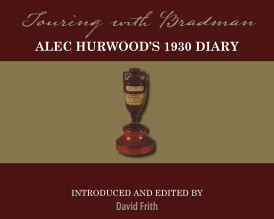Touring With Bradman: Alec Hurwood’s 1930 Diary
Martin Chandler |Published: 2019
Pages: 96
Author: Frith, David
Publisher: The Cricket Press Pty Ltd
Rating: 4.5 stars

Tour diaries were much in vogue until relatively recently, especially in Australia. Steve Waugh produced nine of them, and a couple more titles that were very similar. His successors Ricky Ponting and Michael Clarke were not quite so prolific, but still lent their names to such books. Offhand I can think of offerings from Messrs Hussain, Langer and Harmison as well. Such books tend not to receive a great deal in the way of critical acclaim, and one suspects are not in any event the work of the men whose names appear on the covers.
In days gone by there were plenty of tour books, and whilst that particular genre of cricket writing reached its apogee in the 1950s, there were still three published shortly after the 1930 Ashes. Two were ‘traditional’ accounts by former England players ‘Plum’ Warner and Percy Fender, and in addition there was a rather breezier and informal book from a young Australian journalist, Geoffrey Tebbutt, whose only ever book it was. In addition a retrospective account by Christopher Hilton appeared almost eighty years after the event.
One of the 1930 party was Queenslander Alec Hurwood. He didn’t play in any of the Tests, and his record on the tour was a modest one. But in the days when such things had to be faithfully hand written he did keep a diary, which lay undisturbed during Hurwood’s life and came to light only through the serendipity of a chance meeting between Cricinfo’s Steven Lynch and one of Hurwood’s sons in Melbourne in 2010. Later still renowned historian/author and Cricketweb favourite David Frith got wind of the diary’s existence and this attractive limited edition book has now appeared from The Cricket Press Pty Ltd.
Who was Hurwood? There is a fourteen page introduction from Frith which tells his story. Born in 1902 his father died when he was three, his mother when he was six and his maternal aunt not long afterwards. The thus orphaned Hurwood was brought up by his grandmother and, his becoming a Test cricketer and an accountant, she obviously made a good job of it.
It goes almost without saying that the Frith pen portrait is an excellent one, and the sort of story that is very much of its time. As noted Hurwood missed out on a Test place in 1930, but he did appear in the first two Tests against West Indies in 1930/31. A medium pacer/off spinner Hurwood took 11 wickets at 15.45 in those two Tests. Why did he not play after that? The answer is the prosaic one that he couldn’t get any more time off work, and no doubt for the same reason his First Class career ended a year later. He was still not thirty.
All told Hurwood was away from home for more than eight months and his diary is, inevitably therefore, a travel journal almost as much as a cricketing one. He leaves Brisbane on 5 March, and it is not until eight weeks later that the first tour match begun, and Hurwood’s reader is able to follow his journey across Australia and on to Ceylon, through the Middle East, North Africa and up through Italy and France to England, and the social preliminaries. There are then just over four months of cricket before, and this was something I hadn’t realised, almost three more weeks in England before a rather shorter account of the seven week journey home.
It is probably fair to say that Hurwood was largely the forgotten man of the tour. He played in 19 of the First Class matches, yet took just 28 wickets at 26.21. For a man with a short five pace approach he clearly wasn’t overbowled. At the end of the book Frith, who clearly warmed to Hurwood, quotes Tebbutt’s assessment of his tour at some length. It is easy to see why Hurwood was so well liked. At various points in his diary some disappointment comes through, but there is never any bitterness.
There is an entry for most days in the diary, faithfully transcribed and, like the true professional he is, Frith adds snippets of context and background material from time to time. The book is exceptionally well illustrated with previously unseen pictures from the tour, a few pieces of memorabilia and several of Hurwood’s drawings of field placings, clearly demonstrating that opponent analysis is nothing new.
The modern tour diaries I made reference in my first paragraph were ‘written’ by the stars of their teams. The appearance of an account from a tour’s lesser light gives an unusual perspective to Frith’s book. If there is any disappointment in Touring With Bradman: Alec Hurwood’s 1930 Diary it is the lack of any real input from Hurwood’s three children about their impressions of their father and much information about his life after cricket. But then I have to accept there may be a very good reason for that.
As far as the appearance of the book is concerned it is, as always with this publisher, a credit to all involved in its production. There are 130 hardback copies published on fine quality paper. The first thirty are a special deluxe edition bound in leather and signed by Frith and each of Hurwood’s three children. I suspect this one will sell out quickly and early ordering is recommended.






Leave a comment